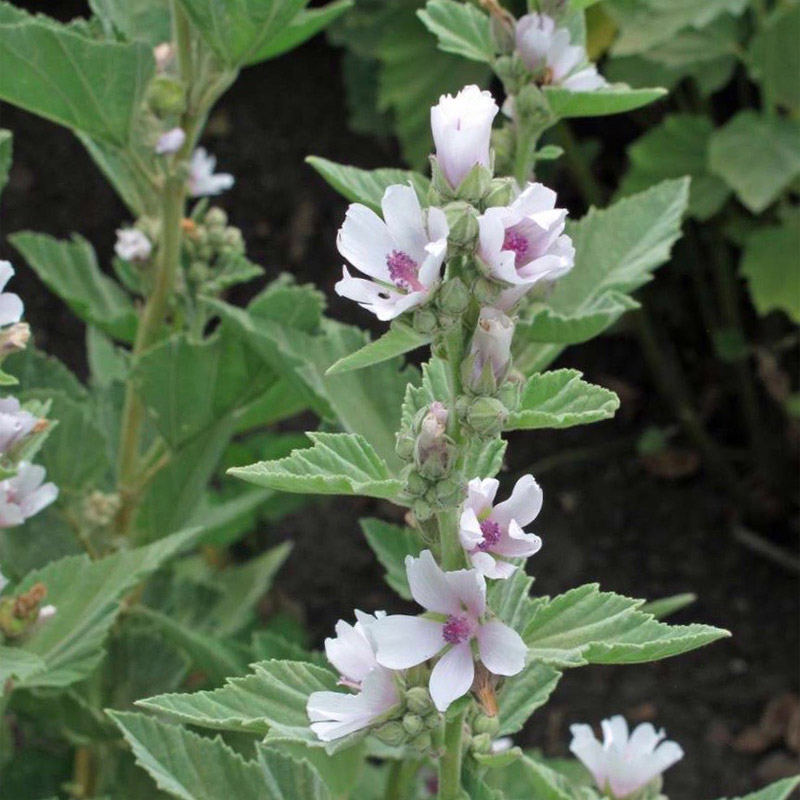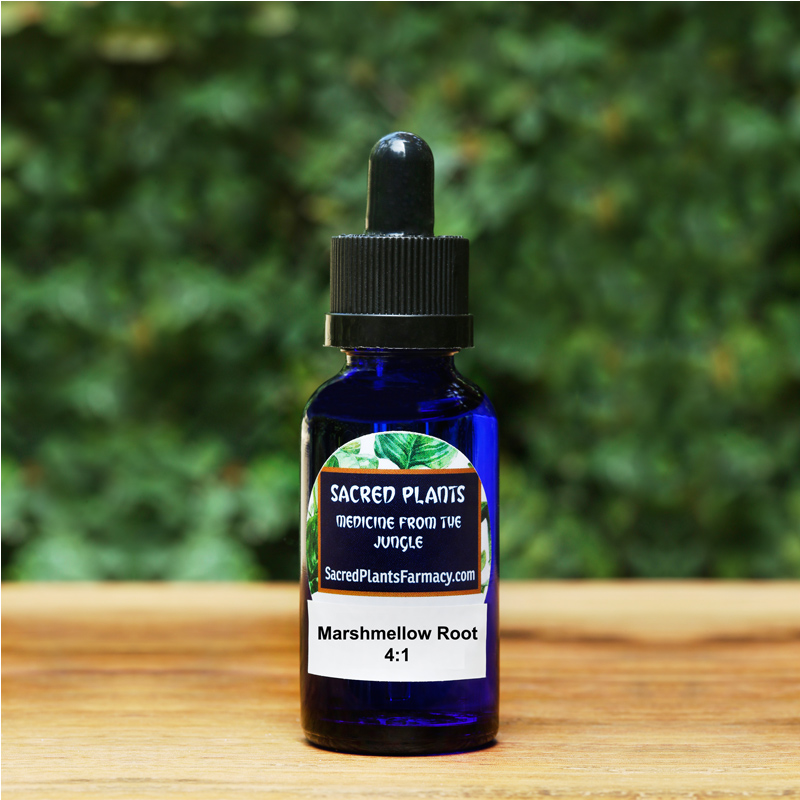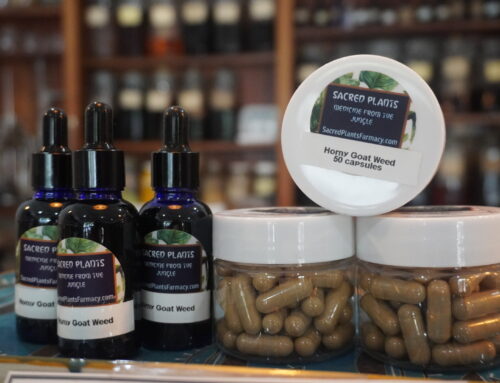Treats coughs and colds
Relieves skin irritation
Aids wound healing
Promotes overall skin health
Acts as a pain reliever
Works as a diuretic
Aids in digestion
Repairs gut lining
Acts as an antioxidant
Supports heart health
Marshmallow root (Althaea officinalis) is a perennial herb that’s native to Europe, Western Asia, and Northern Africa. It’s been used as a folk remedy for thousands of years to treat digestive, respiratory, and skin conditions.
Its healing powers are due in part to the mucilage it contains. It’s typically consumed in capsule, tincture, or tea form. It’s also used in skin products and cough syrups. Sacred Plants Farmacy makes a tincture and also offers a tea.
Keep reading to find out more about the healing potential of this powerful plant.
1. It may help treat coughs and colds
The high mucilaginous content of marshmallow root may make it a useful remedy for treating coughs and colds.
A small study from 2005 found that an herbal cough syrup containing marshmallow root was effective in relieving coughs due to colds, bronchitis, or respiratory tract diseases with formation of mucus. The active ingredient of the syrup was dry ivy leaf extract. It also contained thyme and aniseed.
Within 12 days, all 62 participants experienced an 86 to 90 percent improvement in symptoms. Further studies are needed to validate these findings.
Marshmallow root appears to act as an enzyme to loosen mucous and inhibit bacteria. Lozenges containing marshmallow root extract help dry coughs and an irritated throat.
How to use: Take 10 milliliters (mL) of marshmallow root cough syrup each day. You can also drink a few cups of bagged marshmallow tea throughout the day.
2. It may help relieve skin irritation
The anti-inflammatory effect of marshmallow root may also help relieve skin irritation caused by furunculosis, eczema, and dermatitis.
A review from 2013 found that using an ointment containing 20 percent marshmallow root extract reduced skin irritation. Researchers suggested that the herb stimulates certain cells that have anti-inflammatory activity.
When used alone, the extract was slightly less effective than an ointment containing an anti-inflammatory synthetic drug. However, an ointment containing both ingredients had higher anti-inflammatory activity than the ointments containing only one or the other.
More research is needed to confirm and elaborate upon these findings.
How to use: Apply an ointment containing 20 percent marshmallow root extract to the affected area 3 times per day.
How to do a skin patch test: It’s important to do a patch test before using any topical medication. To do this, rub a dime-sized amount on to the inside of your forearm. If you don’t experience any irritation or inflammation within 24 hours, it should be safe to use elsewhere.
3. It may help with wound healing
Marshmallow root has antibacterial activity that may make it effective in wound healing.
The results of one 2015 animal study suggest that marshmallow root extract has the potential to treat gram-positive bacteria. These bacteria are responsible for over 50 percent of the infections that occur and include the antibiotic-resistant “super bugs.” When applied topically to rat wounds, the extract significantly increased wound healing in comparison to antibiotic controls.
It’s thought to speed up the healing time and reduce inflammation, but further research is needed to confirm these findings.
How to use: Apply a cream or ointment containing marshmallow root extract to the affected area three times per day.
How to do a skin patch test: It’s important to do a patch test before using any topical medication. To do this, rub a dime-sized amount on to the inside of your forearm. If you don’t experience any irritation or inflammation within 24 hours, it should be safe to use elsewhere.
4. It may promote overall skin health
Marshmallow root may be used to enhance the appearance of skin that has been exposed to ultraviolet (UV) radiation. In other words, anyone who’s ever been out in the sun may benefit from applying topical marshmallow root.
Although laboratory research from 2016 supports the use of marshmallow root extract in UV skin care formulations, researchers need to learn more about the extract’s chemical makeup and practical applications.
How to use: Apply a cream, ointment, or oil containing marshmallow root extract in the morning and evening. You can apply it more often after sun exposure.
How to do a skin patch test: It’s important to do a patch test before using any topical medication. To do this, rub a dime-sized amount on to the inside of your forearm. If you don’t experience any irritation or inflammation within 24 hours, it should be fine.
5. It may act as a pain reliever
A study from 2014 cites research that marshmallow root can act as an analgesic to relieve pain. This may make marshmallow root an excellent choice for soothing conditions that cause pain or irritation such as sore throat or an abrasion.
How to use: Take 2–5 mL of liquid marshmallow extract 3 times per day. You can also take the extract at the first sign of any discomfort.
6. It may work as a diuretic
Marshmallow root also has the potential to act as a diuretic. Diuretics help the body to flush out excess fluid. This helps to cleanse the kidneys and the bladder.
Other research suggests that the extract can support overall urinary health. One 2016 study suggests that the soothing effect of marshmallow can relieve internal irritation and inflammation in the urinary tract. Research from 2015 also suggests that its antibacterial effect may be useful in treating urinary tract infections.
How to use: Make fresh marshmallow root tea by adding a cup of boiling water to 2 teaspoons of dried root. You can also buy bagged marshmallow tea. Drink a few cups of tea throughout the day.
7. It may aid in digestion
Marshmallow root also has the potential to treat a wide range of digestive conditions, including constipation, heartburn, and intestinal colic.
Research from 2011 found that marshmallow flower extract demonstrated potential benefits in treating gastric ulcers in rats. Anti-ulcer activity was noted after taking the extract for one month. More research is needed to expand upon these findings.
How to use: Take 2–5 mL of liquid marshmallow extract 3 times per day. You can also take the extract at the first sign of any discomfort.
8. It may help repair gut lining
Marshmallow root may help soothe irritation and inflammation in the digestive tract.
An in vitro study from 2010 found that aqueous extracts and polysaccharides from marshmallow root can be used to treat irritated mucous membranes. Research suggests that the mucilage content creates a protective layer of tissue on the lining of the digestive tract. Marshmallow root may also stimulate the cells that support tissue regeneration.
Further research is needed to expand upon these findings.
How to use: Take 2–5 ml of liquid marshmallow extract 3 times per day. You can also take the extract at the first sign of any discomfort.
9. It may act as an antioxidant
Marshmallow root has antioxidant properties that may help protect the body from damage caused by free radicals.
Research from 2011 found marshmallow root extract to be comparable to standard antioxidants. Although it demonstrated strong total antioxidant activity, further research is needed to elaborate on these findings.
How to use: Take 2–5 mL of liquid marshmallow extract 3 times per day.
10. It may support heart health
Scientists are investigating the potential of marshmallow flower extract in treating various heart conditions.
A 2011 animal study examined the effects of liquid marshmallow flower extract in treating lipemia, platelet aggregation, and inflammation. These conditions are sometimes linked to cardiovascular disease. Researchers found that taking the flower extract for one month had a positive effect on HDL cholesterol levels, promoting heart health. More research is needed to expand on these findings.
How to use: Take 2–5 mL of liquid marshmallow extract upto 3 times per day.
Possible side effects and risks
Marshmallow root is generally well tolerated. In some cases, it can cause upset stomach and dizziness. Starting with a low dose and gradually working your way up to a full dose can help reduce your risk of side effects.
Taking marshmallow root with an 8-ounce glass of water can also help reduce your risk of side effects.
You should only take marshmallow root for four weeks at a time. Be sure to take a one-week break before resuming use.
When applied topically, marshmallow root has the potential to cause skin irritation. You should always do a patch test before moving forward with a full application.
Talk to your doctor if you’re taking other medications before starting marshmallow root, as it’s been found to interact with lithium and diabetes drugs. It can also coat the stomach and interfere with absorption of other medications.
Avoid use if you:
- are pregnant or breastfeeding
- have diabetes
- have a scheduled surgery within the next two weeks
Although marshmallow root is generally considered safe to use, you should still talk with your doctor before taking. The herb isn’t meant to replace any doctor-approved treatment plan.
With your doctor’s approval, add an oral or topical dose into your routine. You can reduce your risk for side effects by starting with a small amount and increasing the dosage over time.
The statements made within this website have not been evaluated by the Food and Drug Administration. These statements and the products of this company are not intended to diagnose, treat, cure or prevent any disease.






